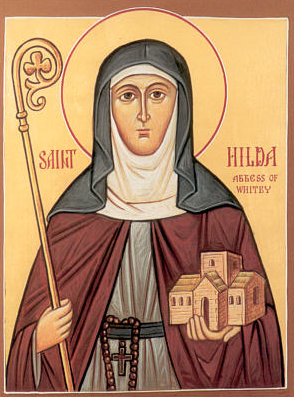According to Bede, Hilda was born in 614, into the Deiran royal household. She was the second daughter of Hereric, nephew of Edwin, King of Deira, and his wife Breguswith. When Hilda was still an infant, her father was poisoned while in exile at the court of the British King of Elmet in what is now West Yorkshire. In 616 CE, Edwin killed Aethefrith, the son of Æthelric of Bernicia, in battle. He created the kingdom of Northumbria and took the throne. Hilda was brought up at King Edwin’s court.
In 625, the widowed Edwin married the Christian princess, Æthelburh of Kent, daughter of King Æthelberht of Kent and the Merovingian princess Bertha of Kent. As part of the marriage contract, Aethelburgh was allowed to continue her Roman Christian worship and was accompanied to Northumbria with her chaplain, Paulinus of York, a Roman monk sent to England in 601 to assist Augustine of Canterbury. Augustine’s mission in England was based in Kent, and is referred to as the Gregorian mission after the pope who sent him. As queen, Æthelburh continued to practice her Christianity and no doubt influenced her husband’s thinking as her mother Bertha had influenced her father.
In 627 King Edwin was baptised on Easter Day, 12 April, along with his entire court, which included the 13-year-old Hilda, in a small wooden church hastily constructed for the occasion near the site of the present York Minster.
In 633 Northumbria was overrun by the neighbouring pagan King of Mercia, at which time King Edwin fell in battle. Paulinus accompanied Hilda and Queen Æthelburh and her companions to the Queen’s home in Kent. Queen Æthelburh founded a convent at Lyminge and it is assumed that Hilda remained with the Queen-Abbess. Hilda’s elder sister, Hereswith, married Ethelric, brother of King Anna of East Anglia, who with all of his daughters became renowned for their Christian virtues. Later, Hereswith became a nun at Chelles Abbey in Gaul (modern France). Bede resumes Hilda’s story at a point when she was about to join her widowed sister at Chelles Abbey. At the age of 33, Hilda decided instead to answer the call of Bishop Aidan of Lindisfarne and returned to Northumbria to live as a nun.
HILDA THE ABBESS
Hilda’s original convent is not known except that it was on the north bank of the River Wear. Here, with a few companions, she learned the traditions of Celtic monasticism, which Bishop Aidan brought from Iona. After a year Aidan appointed Hilda as the second Abbess of Hartlepool Abbey. No trace remains of this abbey, but its monastic cemetery has been found near the present St Hilda’s Church, Hartlepool.
In 657 Hilda became the founding abbess of Whitby Abbey, then known as Streoneshalh; she remained there until her death. Archaeological evidence shows that her monastery was in the Celtic style, with its members living in small houses, each for two or three people. The tradition in double monasteries, such as Hartlepool and Whitby, was that men and women lived separately but worshipped together in church. The exact location and size of the church associated with this monastery is unknown.
Bede states that the original ideals of monasticism were maintained strictly in Hilda’s abbey. All property and goods were held in common; Christian virtues were exercised, especially peace and charity. Everyone had to study the Bible and do good works.
Five men from this monastery later became bishops and two also join Hilda in being revered as saints – John of Beverley, Bishop of Hexham and Wilfrid, Bishop of York. They rendered untold service to the church at this critical period of the struggle with paganism.
HILDA’S HOMILY
Trade with the gifts God has given you.
Bend your minds to holy learning that you may escape the fretting moth of littleness of mind that would wear out your souls.
Brace your wills to action that they may not be the spoils of weak desires.
Train your hearts and lips to song which gives courage to the soul.
Being buffeted by trials, learn to laugh.
Being reproved, give thanks.
Having failed, determine to succeed.



